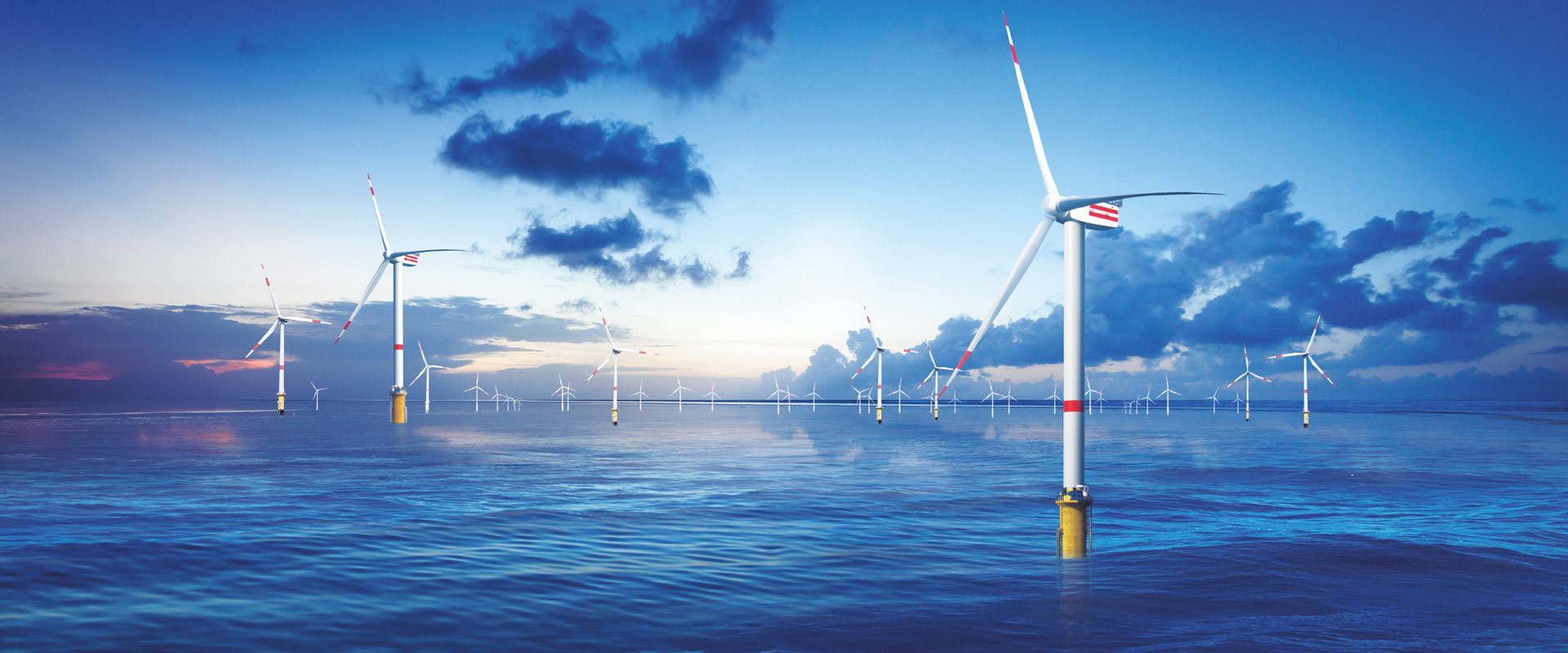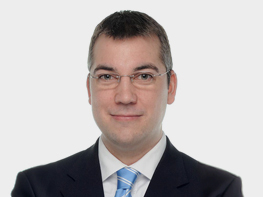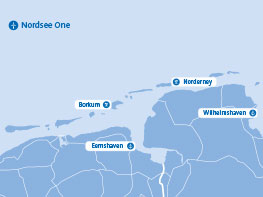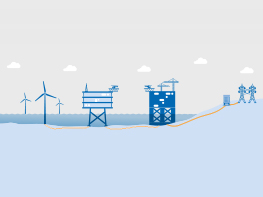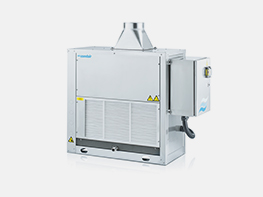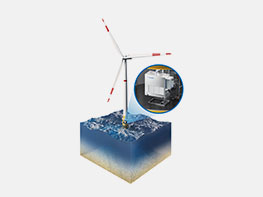Air drying on the high seas
Air Dehumidifier for the Safe Operation of
Offshore Wind Turbines
Renewable electricity generation in offshore wind farms has developed into an important pillar of the environmentally-friendly energy landscape in recent years and it is one of the great hopes of the energy transition. In order for the many thousands of wind turbines operating in the North and Baltic Seas to function safely in the long term, a maximum air humidity must not be exceeded in their operating areas.
Therefore, the air has to be dehumidified almost constantly: failures and repairs of wind turbines far out at sea are very costly and can lead to high income losses. This article explains the problem and its solution using the example of the Nordsee One wind farm, which went into operation at the end of 2017 (see Figure 1). This wind farm comprises 54 wind turbines and has a total capacity of more than 330 MW.
The strong and mostly steady winds that prevail on the high seas make offshore wind energy lucrative. Due to the good conditions, the annual full-load hours for offshore wind turbines are twice as high as those for similar on-land turbines. Around 20,000 MW of electrical capacity is currently installed in wind farms in the North Sea, the Baltic Sea and the Irish Sea. Another 35,000 MW is under construction or at the planning stage. With around 3,500 full operating hours per year, the several thousand wind turbines currently generate 70 billion kWh of electrical work per year; according to the plans, this will be well over 220 billion kWh in 2025. The main green electricity users are the UK, Germany, the Netherlands, Belgium and Denmark.
Germany also relies on wind power
In Germany, the expansion of offshore wind energy is running at full steam. With a total capacity of 5,400 MW, almost 1,200 wind turbines in 20 offshore wind farms were connected to the grid off the German coasts at the end of 2017. According to information from Bundesverband Windenergie [German Wind Energy Association], wind energy contributed around 105 billion kWh, or an approx. 18% share, to German electricity generation (600 billion kWh) in 2017. This means that the electrical work from wind energy is about as substantial as that of photovoltaics, biomass and hydropower combined.
Of the electricity from wind turbines, around 20 billion kWh came from offshore wind farms in 2017 — that was 50% more than the 2016 figure. The German government is also relying heavily on wind power for the coming years: By 2030, a wind capacity of 15,000 MW is to be installed (about 50% each onshore and offshore), which will then generate electricity work of at least 200 billion kWh. This corresponds to about one third of the total German electricity consumption at present. Based on Erneuerbare-Energien-Gesetz [Renewable Energy Sources Act] (EEG), the initial remuneration for offshore wind turbines is currently 15.4 cents/kWh for the first twelve years, and 3.9 cents/kWh thereafter.
Nordsee One supplies 1,200 million kWh of electricity per year
The Nordsee One wind farm is located about 35 km north of the island of Juist in the southern North Sea. It has a total area of 41 km2 and the water depth is 26–29 m (see Figure 2). The average wind speed is 10 m/s. Almost ten years after the Federal Maritime and Hydrographic Agency had given the Nordsee One wind farm the green light, construction started at the end of 2015. The foundations for the 54 wind turbines were ready in April 2016, the transformer platform was erected in the summer, and by the end of September 2017, all 54 wind turbines had been assembled.
Nordsee One went into operation in December 2017 and has been supplying green electricity ever since. It uses 54 wind turbines with a rotor diameter of 126 m and a nominal capacity of 6.15 MW each. The wind turbine kicks in at wind speeds of 3.5 m/s and above and reaches its maximum output at around 12 m/s. The rotors have a total area of 12,500 m² — the size of one and a half football fields!
The total capacity of all 54 turbines is 332 MW. With about 3,600 full power hours, the wind farm operators expect to generate about 1,200 million kWh of electricity per year. This electricity corresponds to the annual consumption of about 400,000 households and saves one million tonnes of CO2 per year, which would otherwise be produced in power plants to generate electricity. The wind farm is expected to operate for at least 25 years.
Electricity from the North Sea onto land
The 54 wind turbines are connected to the transformer platform by medium-voltage cables, which transform the electricity to a high voltage of 155 kV. From there, two submarine cables carry the electricity seven kilometres to the offshore converter platform (32 m x 16 m x 18 m). This is used as a collection station, where the electricity is transformed into direct current. Two 320 kV cables finally transmit the electricity to the Dörpen West substation on-land entry point (see Figure 3).
Operational safety as the top priority
Often located many kilometres from land, wind turbines must have maximum operational reliability. Since the MW systems generate significant returns, operators stand to lose a lot of money in the event of turbine failures. Necessary repairs may often be delayed for days due to weather conditions. When seas are rough, service teams are exposed to high stresses due to journeys lasting several hours and difficult transfers from ship to wind turbine. Transfers by helicopter are faster but more expensive, and often have to be cancelled in fog and strong winds. Therefore, remote electronic plant monitoring and redundant systems are standard for wind turbines, as are regular inspections and maintenance of the foundations, rotor blades and all electronics carried out by specialist companies.
The North Sea One project was supplied with a total of 54 type DC 75 dehumidifiers by Condair GmbH, Garching (see Figure 4). The air needs to be continuously dehumidified to a relative humidity of about 50–60% to protect them from excessive humidity and corrosion. The condensate produced in the process is removed automatically on an ongoing basis. In the case of the Nordsee One project, these rooms in which the dehumidifiers are used, each measuring approx. 135 m³ (diameter 5.5 m, height 5.7 m), are each located in the water surface area (see Fig. 5). At compact dimensions of 800 mm x 820 mm x 400 mm, type DC 75 dehumidifiers operate based on condensation dehumidification, i.e. by undercutting the air’s dew point, using a refrigeration circuit (refrigerant: R410A).
At an air flow rate of 800 m³/h, the maximum dehumidification capacity is 73 l per day. A special feature of the units supplied for Nordsee One is the special, very high-quality offshore design with maximum protection against the aggressive, salty sea air. This includes, for example, stainless steel housing, robust special heat exchangers made of copper/copper as well as a special paint finish for the EC fans and the insulated refrigerant lines. The IP66/67 rated unit electronics (including fault management) are located in a separate electrical box. The demand-controlled hot gas defrosting ensures economical operation even at low indoor temperatures.
Dipl.-Ing. (FH) Sebastian Strutz, Condair Regional Centre North, Laatzen-Rethen..
